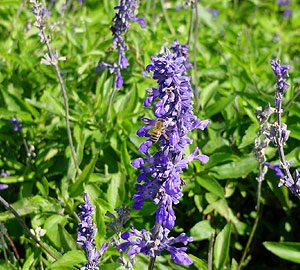Dallas, Texas
March 30, 2006
Duranta and a variety of salvia
named Henry Duelberg have been awarded Texas Superstar
designations by Texas Cooperative Extension.
|
 |
|
A Sulphur
butterfly enjoys the nectar from duranta
flowers. The plant's fruit, in the
background, is also enjoyed by wildlife.
(Texas Cooperative Extension photo by Jerry
Parsons)
|
|
Duranta is a plant with a
long history and many names but one consistent quality: it meets
all six of the characteristics required to receive Texas
Superstar designation.
Researchers Dr. Cynthia McKenney and Dr. Wayne Mackay, both
horticulturists with the Texas Agricultural Experiment Station
in Dallas, said those characteristics include being attractive
and useful to a broad spectrum of gardeners.
They said the plant also offers ornamental characteristics not
usually available in commonly sold plants. Duranta performs
consistently well for Texas consumers regardless of their
gardening expertise. It is as pest resistant as possible. It has
been propagated and mass produced for consumers. And last but
not least, both said duranta is attractive enough to sell itself
without the consumer knowing anything else about it.
Duranta puts out a sky blue flower or a royal blue flower on
weeping or drooping type branches throughout the summer and is
followed by yellow berries in the fall.
A variegated cultivar named Duranta Golden Edge is grown just
for its foliage. Duranta blooms from late summer into autumn. It
rapidly grows to two to three feet in height.
"Duranta is a tropical annual with beautiful blue flowers and is
a perennial in the subtropical portions of Texas," said Mackay.
"The plants perform very well in containers and make great patio
plants for sun and shade. Although the variegated form does not
flower, it is especially useful in the shade to provide color."
"Duranta attracts birds, butterflies and hummingbirds," said
McKenney.
"One of the nicest parts about Duranta is that it can take sun
or shade and does very well in our heavy clay soils."
Up to 30 species of tropical trees and shrubs make up the genus
Duranta L. The duranta designated as a Texas Superstar is
scientifically known as Duranta erecta, but is more commonly
called Lilac-Flowered Golden Dewdrop, Brazilian Sky Flower,
Pigeon Berry or simply Duranta. This year's other new Texas
Superstar is the Henry Duelberg salvia. It was named from the
grave marker in a rural Central Texas cemetery where it was
found growing.
|
 |
|
Bees enjoy the
nectar from the dark blue flowers of Henry
Duelberg salvia. (Texas Cooperative
Extension photo by Jerry Parsons) |
|
The Henry Duelberg salvia
has dark blue flowers. Another variety named Augusta Duelberg,
after Henry's wife, has white flowers. Both varieties are heat
and drought tolerant, grow 2 to 3 feet tall, thrive on full sun
and provide good color throughout their blooming season, which
is May through the first frost, said McKenney.
"The Henry Duelberg salvia is a really nice ‘discovered'
salvia," said McKenney. "It's a good plant for the whole state.
I expect that we're going to see the Henry Duelberg Salvia
promotion do well as salvias as a whole do well in Texas."
"Henry Duelberg salvia is more vigorous than other salvias and
it performs best when sheared occasionally to renew the flowers
and keep the plant tidy," said Mackay.
With the announcement of these two newest Texas Superstars, the
number of plants that have received the designation now tops
three dozen.
"These are not all native Texas plants," McKenney said. "Some
are old favorites and some are new to the industry. One thing
they all have in common is that they are all high-performing
plant materials that are environmentally tolerant."
McKenney said plants that receive the Texas Superstar
designation are tested for at least three years to make sure
they will perform effectively throughout most if not all of the
state. Categories of Texas Superstars include ornamental, annual
and perennial plants as well as some trees, shrubs, fruits and
vegetables.
"The Texas Superstars are plants that the Texas Agriculture
Program has searched and trialed to find easy care, attractive
ornamentals with minimal care," McKenney said. "These plants fit
into the EarthKind landscape management program that is headed
by Texas Cooperative Extension. It is a management practice to
maximize the health and growth of plants with the least amount
of energy or chemical inputs, so it is an environmentally
friendly program. In the future we will probably look at
container and color bowl combinations as well as possibly
interior foliage plants."
Writer: Janet Gregg |